NCERT Exemplar Solutions for Class 10 Science Chapter 6 Life Processes
These Solutions are part of NCERT Exemplar Solutions for Class 10 Science. Here we have given NCERT Exemplar Solutions for Class 10 Science Chapter 6 Life Processes
NCERT Exemplar Solutions for Class 10 Science Chapter 6 Short Answer Questions
Question 1.
Name the following :
-
- The process in plants that links light energy with chemical energy.
- Organisms that can prepare their own food.
- Cells that surround a stomatal pore.
- The cell organelle where photosynthesis occurs.
- Organisms that cannot prepare their own food.
- An enzyme secreted by gastric glands in stomach that acts on proteins.
Answer:
- Photosynthesis
- Autotrophs
- Guard cells
- Chloroplast
- Heterotrophs
- Pepsin.
More Resources
- NCERT Exemplar Solutions for Class 10 Science
- NCERT Solutions for Class 10 Science
- Value Based Questions in Science for Class 10
- HOTS Questions for Class 10 Science
- Previous Year Question Papers for CBSE Class 10 Science
Question 2.
“All plants give out oxygen during day and carbon dioxide during night.” Do you agree with the statement ? Give reason.
(CCE 2010)
Answer:
Yes. Respiration is going on throughout day and night. Photosynthesis occurs only during the day. Rate of photosynthesis is several times the rate of respiration. All the CO2 produced in respiration is also consumed in photosynthesis during the day time. Therefore, during day time, plants give out oxygen, which is a product of photosynthesis. However, during night when there is no photosynthesis, plants liberate carbon dioxide.
Question 3.
How do the guard cells regulate opening and closing of stomatal pores ? (CCE 2010, 2012)
Answer:
Opening and closing of stomata is regulated by gain or loss of turgidity of their guard cells. During opening of stomata, guard cells withdraw K+ ions from surrounding epidermal cells, followed by absorption of water from them. As a result, guard cells swell up and become turgid. Their outer thin and elastic walls bend outwardly followed by outward movement of thicker inner walls. The latter creates a pore in between the two guard cells.
During closure movement of stomata, guard cells send out K+ ions. Water also passes out. Guard cells become flaccid. Their inner thick walls come to touch each other. The stomatal pore gets closed.
Question 4.
Two green plants are kept separately in oxygen free containers, one in dark and the other in continuous light. Which one will live longer ? Give reasons. (CCE 2010)
Answer:
Plant kept in continuous light will live longer due to
- Manufacture of food and hence its availability to the plant for maintenance and growth,
- Production of oxygen in photosynthesis and its availability for respiration of the plant. Plant kept in oxygen free container kept in dark will die within a few days due to non-availability of food and oxygen.
Question 5.
If a plant is releasing carbon dioxide and taking in oxygen during the day, does it mean that there is no photosynthesis occurring ? Justify your answer.
Answer:
A plant releases carbon dioxide and takes in oxygen only when photosynthesis is either absent or too small as not to compensate for respiration.
(In photosynthesis, plants absorb CO2 and release O2. The normal rate of photosynthesis is many times the rate of respiration. As a result, CO2 produced during respiration is consumed and a lot of more is absorbed from outside. Oxygen produced during photosynthesis is much more than required for respiration. Therefore, oxygen passes out.)
Question 6.
Why do fishes die when taken out of water ?
Answer:
Fish taken out of water die due to
- Inability to obtain oxygen from air
- Collapsing of gill lamellae so that no space is left for gaseous exchange.
Question 7.
Differentiate between an autotroph and a heterotroph.
Answer:
| Autotroph | Heterotroph |
| 1. Food: It manufactures its own food. | It obtains its food from outside sources. |
| 2. Chlorophyll: It has chlorophyll for performing photosynthesis. | Chlorophyll is absent. |
| 3. Energy: It is obtained from sunlight and changed into chemical energy. | It does not require an external source of energy as the same is present in food obtained from outside. |
| 4. Digestion: It is absent. | Food obtained from outside is digested before being absorbed and assimilated. |
Question 8.
Is nutrition a necessity for an organism ? Discuss.
Answer:
Yes, nutrition is a must for an organism because of the following reasons :
Importance of Nutrition/Food
- Food provides energy: Energy is required by the body all the time, whether asleep, taking rest or doing work. When the body is not doing any apparent work, energy is still being consumed in maintaining order. Further, biosynthetic activities continue for replacing materials being consumed or degraded. A number of other activities are going on all the time. Heart is always beating. Breathing movements never stop. Food eaten by a person has to be digested and absorbed. Excretory products are being produced.
- Body Structure: All body components are built up of materials obtained from food.
- Food is used in building protoplasm. More protoplasm is required for formation and enlargement of cells that take part in growth of the organism.
- Food provides materials for replacement and repair of worn out or damaged structures.
- Hormones and enzymes are formed from ingredients of food. They regulate metabolism and body functions. ‘
- Defence system of the body is formed from raw materials got- from food.
- Food provides materials to form reproductive structures.
Question 9.
What would happen if green plants disappear from earth ?
Answer:
Herbivores will die of starvation followed by carnivores and then decomposers.
Question 10.
Leaves of a healthy plant were coated with vaseline. Will this plant remain healthy for long ? Give reasons for your answer.
Answer:
The plant will not remain healthy for long. Vaseline covers the cuticle and blocks the stomata. As a result
- It is unable to obtain oxygen from air for respiration,
- It is unable to perform photosynthesis as no carbon dioxide diffuses from air.
- In the absence of transpiration, the leaves get heated up and injured.
Question 11.
How does aerobic respiration differ from anaerobic respiration ?
Answer:
| Aerobic Respiration | Anaerobic Respiration |
| 1. Method: It is the common method of respiration. | It occurs permanently only in a few organisms. In others it may occur as a temporary measure to overcome shortage of oxygen. |
| 2. Steps: It is completed in 3 steps—glycolysis, Krebs cycle and terminal oxidation. | There are two steps— glycolysis and anaerobic breakdown of pyruvic acid. |
| 3. Oxygen: It requires oxygen. | Oxygen is not required. |
Question 12.
Match the words of column A with those of column B
| A | B |
|
(a) Phloem (b) Nephron (c) Veins (d) Platelets |
(i) Excretion (ii) Translocation of food. (iii) Clotting of blood (iv) Deoxygenated blood. |
Answer:
a — ii,
b — i,
c —iv,
d —iii.
Question 13.
Differentiate between an artery and a vein. (CCE 2013)
Answer:
| Artery | Vein |
| 1. Direction of Flow: It carries blood from heart to an organ. | It brings blood from an organ towards the heart. |
| 2. Speed: Blood flow is rapid in artery. | Blood flow is slow in vein. |
| 3. Jerks: Blood flows with jerks. | Blood flows smoothly. |
| 4. Pressure: Blood flows under pressure | There is little pressure. |
| 5. Internal Valves: They are absent. | Internal valves are present to prevent back flow. |
| 6. Wall: It is thick and elastic. | It is comparatively thinner and little elastic. |
| 7. Lumen: Narrow. | Wide. |
| 8. Type of Blood: Artery carries oxygenated blood except pulmonary arteries. | Vein carries deoxygenated blood except pulmonary veins. |
| 9. Occurrence: It is deep seated. | It is superficial. |
| 10. Collapsibility: Artery is not collapsible. | Vein is collapsible. |
| 11. Blood After Death: It does not contain blood after death. | Vein is full of blood even after death. |
Question 14.
What are the adaptations of leaf for photosynthesis ?
Answer:
- Large Surface Area : Leaf has a large surface area to absorb maximum amount of lift.
- Leaf Orientation: It is such as to absorb the optimum amount of light.
- Veins: A number of veins occur in a leaf. They provide mechanical strength to the otherwise soft leaf. Veins also take part in quick transport of substances to and from the mesophyll cells.
- Transpiration: Leaf is the seat of transpiration. Transpiration cools the surface of leaf for optimum photosynthesis.
- Gaseous Exchange: A leaf has a large number of stomata for gaseous exchange, required for photosynthesis.
- Chloroplasts: A very large number of chloroplasts occur in the mesophyll of a leaf for efficient photosynthesis.
Question 15.
Why is small intestine in herbivore longer than in carnivores ? (CCE 2013)
Answer:
Herbivorous diet has a large bulk. It is rich in cellulose. However, cellulose digesting enzymes are absent in them. For digestion
of cellulose, herbivores depend upon bacteria. The food has to be kept for longer period in the intestine for complete digestion of cellulose. Therefore, small intestine where bacterial digestion of cellulose occurs has to be long. There is no such requirement in carnivores as their diet has a smaller bulk which does not contain cellulose. They have a shorter intestine.
Question 16.
What will happen if mucus is not secreted by gastric glands ?
Answer:
Mucus protects the stomach from corrosion by HCl and pepsin of gastric juice. In the absence of mucus, the lining layer of stomach wall will be corroded forming gastric ulcers. There will be excessive acidity and extreme discomfort.
Question 17.
What is the significance of emulsification of fats ?
Answer:
Emulsification of fat is the conversion of large fat pieces into very fine fat globules which can be efficiently acted upon by lipase.
Question 18.
What causes movement of food inside the alimentary canal ?
Answer:
Involuntary movement consisting of rhythmic contraction and expansion of the alimentary canal called peristalsis.
Question 19.
Why does absorption of digested food occur mainly in the small intestine ?
Answer:
- Digestion of food is completed only in small intestine.
- Wall of the intestine bears a number of finger-like projections called villi. Villi provide a large surface area to the lining layer for absorption.
- The epithelium, lining the villi, is made of cells having a number of very fine projections known as microvilli. Microvilli are specialised for absorption.
- Wall of the intestine, especially the interior of villi, has lymph and blood vessels for carrying the absorbed food to different parts of the body.
Question 20.
Match the articles of columns A and B :
| A | B |
|
(a) Autotrophic nutrition (b) Heterotrophic nutrition (c) Parasitic nutrition (d) Digestion in food vacuoles |
(i) Leech
(ii) Paramoecium (iii) Deer (iv) Green plant. |
Answer:
a — iv,
b — iii,
c—i,
d — ii.
Question 21.
Why is the rate of breathing in aquatic organisms much faster than in terrestrial organisms ? (CCE 2011, 2012)
Answer:
Most of the aquatic organisms obtain oxygen from water. The amount of dissolved oxygen is quite small as compared to the amount of oxygen in air. Therefore, in order to obtain required oxygen from water, the aquatic animals like fishes have to breathe much faster as compared to the terrestrial organisms.
Question 22.
Why is blood circulation in human heart called double circulation ? (CCE 2011)
Answer:
Blood circulation in human heart is called double circulation as blood passes twice through the heart in order to complete one cycle—once through right side as deoxygenated blood and once through left side as oxygenated blood. Deoxygenated blood passes to lungs. It returns to left side as oxygenated blood. Oxygenated blood is supplied to different parts of the body. It returns to right side of the heart as deoxygenated blood.
Question 23.
What is the advantage of having four chambered heart ? (CCE 2010)
Four chambered heart ensures complete separation of oxygenated and deoxygenated bloods. Only oxygenated blood is pumped out to supply all parts of the body. It is received by left auricle from lungs and pumped out by left ventricle. The blood returns to heart after deoxygenation. It is received by right auricle and pumped out by right ventricle to lungs for oxygenation. The mechanism is useful to animals with high energy needs (due to thermoregulation and higher activity) such as birds mammals.
Question 24.
Mention the major events during photosynthesis. (CCE 2011, 2012)
Answer:
- Photolysis: With the help of light energy, oxygen evolving Z-complex splits up water into its components —- protons (H+), electrons (e–) and oxygen.

- Absorption of Light Energy: Chlorophyll absorbs light energy.
- Primary Reaction: Chlorophyll converts the absorbed light energy into chemical energy. It is called primary reaction of photosynthesis. It builds up ATP with the help of excited electrons.
- Formation of Reducing Power: Coenzyme NADP+ is changed to reduced form of NADPH.

- Reduction of CO2: Carbon dioxide is reduced enzymatically with the help of NADPH and ATP to form carbohydrates.

Question 25.
In each of the following situations, what happens to the rate of photosynthesis ?
(a) Cloudy days
(b) No rainfall in the area
(c) Good manuring
(d) Stomata get blocked due to dirt.
Answer:
(a) Cloudy Days: Photosynthesis is reduced due to low light intensity.
(b) No Rainfall: Rate of photosynthesis decreases due to wilting of leaves, closure of stomata and reduced availability of hydration.
(c) Good Manuring: Rate of photosynthesis increases as good manuring increases soil fertility by providing more minerals, moisture and aeration.
(d) Blocked Stomata: It decreases the rate of photosynthesis by reducing gaseous exchange and non-cooling of leaves due to reduced transpiration.
Question 26.
Name the energy currency in the living organisms. When and where is it produced ?
Energy Currency. ATP (adenosine triphosphate) is the energy; currency of the living beings.
It is produced both during respiration (in all organisms) and photosynthesis (in plants only).
Question 27.
What is common amongst Cuscuta, Ticks and Leeches ?
Answer:
All are parasites which obtain their nutrition from their hosts direcdy without killing them.
Question 28.
Explain the role of mouth cavity in digestion of food.
Answer:
- Moistening of food with saliva,
- Tongue helps in thorough mixing of food with saliva.
- Crushing of food into smaller pieces by teeth,
- Partial digestion of starch by enzyme amylase contained in saliva,
- Rolling of crushed, moistened and partially digested food into small ball or bolus by the tongue.
Question 29.
What are the functions of gastric glands present in the wall of stomach ? (CCE 2011)
Answer:
Gastric glands produce the following substances :
- Mucus: Moistening the food and protecting the wall of the stomach from corroding action of HCl and pepsin.
- HCl: It makes the food soft, sterilised and acidified for pepsin to act upon food.
- Gastric Lipase: It is active only in infants. It partially breaks down fat into its components.
- Rennin: It is active in infants where it helps in curdling of milk (casein to paracasein) for action of pepsin.
- Pepsin: It is secreted in inactive state of pepsinogen. Pepsin hydrolyses proteins into soluble fragments of peptones and proteoses.
Question 30.
Match the items of columns A and B
| A | B |
|
(a) Trypsin (b) Amylase (c) Bile (d) Pepsin |
(i) Pancreas
(ii) Liver (iii) Gastric glands (iv) Saliva |
Answer:
a — i,
b — iv,
c — ii,
d — iii.
Question 31.
Name the correct substrates for the following enzymes :
(a) Trypsin
(b) Amylase
(c) Pepsin
(d) Lipase.
Answer:
(a) Trypsin: Proteins, peptones and proteoses,
(b) Amylase: Starch, dextrins.
(c) Pepsin: Proteins.
(d) Lipase: Fats.
Question 32.
Why do veins have thin walls as compared to arteries ?
Answer:
In arteries, blood flows under pressure so that their walls are thick and elastic. In veins the blood is Therefore, their walls are thin. Rather, they possess semilunar valves to check back flow of blood.
Question 33.
What will happen if platelets were absent in the blood ?
Answer:
Blood platelets are a source of thromboplastin which is essential for blood clotting at the place of injury. In the absence of blood platelets, blood clotting will be litde resulting in greater loss of blood from the place of injury.
Question 34.
Plants have low energy needs as compared to animals. Explain.
Answer:
Plants are anchored. They do not move about. Most of their body is made of dead cells and cell walls. Therefore, their requirement for energy is quite low as compared to animals which move about fast in search of food, mate and shelter.
Question 35.
Why and how does water enter continuously into root xylem ?
Answer:
Root cells in the absorbing part of root pick up ions actively from soil. Ions pass inwardly increasing osmotic concentration of xylem. Because of it soil water (which has very low osmotic concentration) continuously passes into root xylem.
Question 36.
Why is transpiration important for plants ?
Answer:
Importance
- Cooling: Evaporation of water from the aerial parts results in lowering of their temperature which will otherwise rise due to exposure to sun.
- Concentration of Minerals: Transpiration helps in increasing concentration of minerals present in rising water.
- Transport: It creates a pull that helps in transport of water and minerals.
Question 37.
How does leaves of plants help in excretion ? (CCE 2016)
Answer:
Waste materials produced in plant cells are stored ’in their vacuoles. In leaves, the waste materials are
- Stored in vacuoles of mesophyll and epidermal cells,
- Oxalic acid is crystallised as calcium oxalate.
- Nitrogenous wastes are changed into alkaloids
- Vaste aromatic compounds are changed into tannins. As the old leaves fall, the waste materials are also removed from the plant.
NCERT Exemplar Solutions for Class 10 Science Chapter 6 Long Answer Questions
Question 38.
Explain the process of nutrition in Amoeba.
Answer:
- Ingestion: (L. ingestus — taken in). It is taking in of solid food with the help of temporary or permanent mouth. Amoeba can ingest food particles from any point on its surface. Paramoecium (another unicellular organism) has fixed point for the same. Amoeba captures food with the help of temporary finger-like processes called pseudopodia. Paramoecium has small hair-like processes called cilia. Beating of cilia creates current in water that pushes food particle through cytostome or cell mouth. The process of ingestion of solid food particle by a cell or unicellular organism is called phagocytosis.
As soon as Amoeba comes in contact with a food particle or prey, it throws pseudopodia all around the same. The tips of encircling pseudopodia fuse and the prey comes to lie in a vesicle or phagosome.
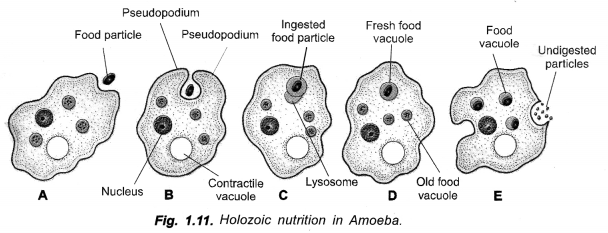
- Digestion: It is conversion of complex insoluble food ingredients into simple absorbable form. Digestion can be intracellular or intercellular. Intercellular digestion occurs in a digestive tract. Intracellular digestion takes place in the cytoplasm of cells. Here, a lysosome fuses with phagosome to produce a food vacuole, also called gastriole or temporary stomach. Reaction of food vacuole is acidic at first and alkaline later on. Digestion of food occurs with the help of digestive enzymes brought by lysosome. It changes complex insoluble substances of food into simpler absorbable substances.
- Absorption: The digested simple and soluble substances pass out of food vacuole into the surrounding cytoplasm.
- The absorbed food materials are converted into various constituents of protoplasm including food reserve.
- (L. egestus — discharge): It is throwing of undigested components of food out of the body. In Amoeba, the old food vacuole with heavier undigested material reaches the rear end, passes to the surface, fuses with surface membrane and throws out the undigested materials. The process is called egestion. Paramoecium has a definite cytopyge or cell anus.
Question 39.
Describe the alimentary canal of man.
Answer:
Alimentary canal (L. alere-to nourish) is a tubular passage extending from mouth to anus through which food passes during its digestion and absorption. It is about 9 metres in length. Alimentary canal consists of mouth, buccal cavity, oesophagus, stomach, small intestine, large intestine and anus.
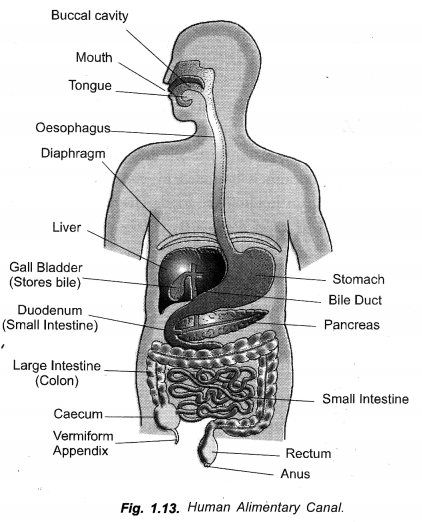
- Mouth: It is a transverse slit like aperture that occurs in between the nose and the chin. Mouth is bounded by two soft, movable sensitive lips, upper and lower. Lips help in holding the food. They also aid in phonation (speech).
- Buccal or Oral Cavity (L. bucca-cheek): It is anterior part of alimentary canal that extends from mouth to pharynx and lies between two jaws, upper (fixed) and lower (movable). It has palate on upper side, throat and tongue on the lower side and cheeks on the lateral sides. Both the jaws contain teeth in semicircular rows or arches.
- It is a muscular, sensory, movable and protrusible flat structure which is attached posteriorly over the lower jaw. Tongue bears taste buds for tasting the quality of food—sweet anteriorly, salt anterio-laterally, sour postero-laterally and bitter posteriorly. It moves food in ‘the buccal cavity for crushing under teeth, mixing with saliva and pushing the food during swallowing. Tongue cleans the teeth. It also aids in phonation (speech). It functions as a movable spoon during drinking.
- They are hard structures which are used for cutting, chewing and crushing the food (physical digestion). They are partially embedded in sockets of jaw bones (thecodont). Teeth are made of ivory like substance called dentine. The exposed parts of teeth or crowns are covered by a shining substance called enamel. Enamel is the hardest substance of the body.
- Salivary Glands. Three pairs of salivary glands (saliva secreting glands) open into buccal cavity. They are parotid (below ears), sub-maxillary (at the angles of lower jaw) and sublingual (below tongue). About 1-0-1-5 litres of near neutral saliva is poured into buccal cavity every day. Saliva consists of mucus, water, lysozyme and enzyme ptyalin.
Question 40.
Explain the process of breathing in man.
Answer:
Breathing or the process of taking in fresh air and releasing foul air can be easily observed because thorax shows alternate expansion and contraction. It is involuntary though it can be prevented for a brief period. Rate of breathing is controlled by respiratory centre of brain. Expansion of thorax causes fresh air to be drawn in. Contraction of thorax causes foul air to be expelled. Therefore, breathing consists of two steps, inspiration and expiration.
- Inspiration or Inhalation: It is bringing of fresh air into lungs for exchange of gases. During inhalation, thoracic cavity enlarges due to two types of inspiratory muscles, phrenic and external intercostals. Phrenic muscles straighten the diaphragm by moving its curved part downwards. It increases length of thorax. Contraction of external intercostal muscles pushes the rib cage in outward and upward direction. It increases girth of thorax. Being air tight, increase in size of thoracic cavity causes expansion of lungs. It decreases air pressure in the lungs. As a result outside air rushes into lungs through external nostrils, nasal cavities, internal nostrils, pharynx, larynx, trachea, bronchi, bronchioles to alveoli. While passing through respiratory tract, the incoming air is :
- Filtered by hair present in anterior part of nasal cavities.
- Cleansed of dust and microbes throughout respiratory tract by lysozyme, mucus and cilia.
- Air conditioned (bringing temperature of inhaled air to that of body) with the help of blood capillaries present below nasal epithelium.
- Moistened by water vapours from wet epithelium.
- Exchange of Gases: It occurs in the alveoli. Fresh air has high concentration of oxygen and a very low concentration of carbon dioxide. As a result, oxygen diffuses from alveolar air to blood present in capillaries around the alveoli. Carbon dioxide diffuses from blood into alveolar air.
Question 41.
How do carbohydrates, proteins and fats get digested in human beings ?
Answer:
Carbohydrates: Glucose.
Proteins: Amino acids.
Fats: Fatty acids and glycerol.
Hints:
- Carbohydrates: In mouth cavity (by saliva), duodenum (by pancreatic juice) and jejunum (by intestinal juice).
- Proteins: In stomach (by gastric juice), duodenum (by pancreatic juice) and jejunum (by intestinal juice).
- Fats: In duodenum and jejunum (by pancreatic juice aided by bile salts). Also in infants in stomach.
Question 42.
Explain the mechanism of photosynthesis.
Answer:
Mechanism of Photosynthesis:
Photosynthesis is formation of organic food from carbon dioxide and water with the help of sunlight inside chlorophyll containing cells. Oxygen is produced as by-product.

Oxygen comes from water. Hydrogen of water is used to reduce carbon dioxide to form carbohydrate.

Actually, photosynthesis occurs in two steps, photochemical and biochemical.
1. Photochemical Phase (Light or Hill Reaction): The reactions of this phase are driven by light energy. They are of two types— photolysis of water and formation of assimilatory power.
(a) Photolysis of Water. Light energy splits up water into its components. Mn2+, CL and Ca2+ are required for this.
![]()
(b) Formation of Assimilatory Power: Light energy absorbed by chlorophyll molecules is used in synthesis of ATP and NADPH.
Both ATP and NADPH2 together form assimilatory power.

2. Biosynthetic Phase (Dark or Blackman’s Reaction). It is actually light independent reaction which can occur both in light as well as in dark. It requires the energy and reducing power contained in assimilatory power of light reaction. Common pathway of biosynthetic phase is Calvin cycle. Carbon dioxide combines with ribulose bisphosphate in the presence of enzyme ribulose biphosphate carboxylase or rubisco. It produces two molecules of phosphoglyceric acid (PGA).
![]()
3. In the presence of ATP, phosphoglyceric acid is reduced by NADPH2 to form glyceraldehyde phosphate (GAP).
![]()
4. A part of glyceraldehyde phosphate is changed into dihydroxyacetone phosphate. The two condense and form glucose. Ribulose biphosphate is regenerated to combine with carbon dioxide again. Glucose undergoes condensation to form reserve carbohydrate called starch.
5. Other inorganic Raw Materials: Synthesis of carbohydrates during photosynthesis is a mechanism to form food materials for body building and releasing energy.
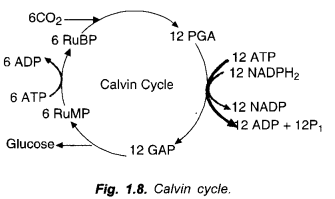
Plants also require a number of other inorganic raw materials or minerals from soil for building other, e.g., nitrogen, phosphorus, iron, sulphur, magnesium, etc. Nitrogen and sulphur are required for building proteins. Phosphorus is required for synthesis of nucleotides. Minerals are absorbed in the form of ions, e.g., NO2– and NH4+ for nitrogen. Some bacteria convert atmospheric nitrogen into compounds of nitrogen. Parts of them become available to plants.
Question 43.
Explain the three pathways of breakdown (respiration) in living organisms.
Answer:
(i) Aerobic Respiration:
It is a multistep complete oxidative breakdown of respiratory substrate into carbon dioxide and water with the help of oxygen acting as a terminal oxidant. Aerobic respiration is the usual mode of respiration in all higher organisms and most of the lower organisms. The reason is that it yields maximum amount of energy. The energy is stored in some 38 molecules of ATP.
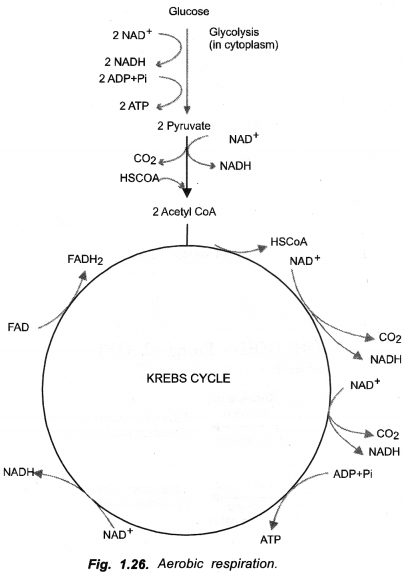
Aerobic respiration occurs in two steps, glycolysis and Krebs cycle.

Glycolysis: Glycolysis or EMP (Embden, Meyerhof and Parnas) pathway is the first step of respiration which is common to both aerobic and anaerobic modes of respiration. It occurs in cytoplasm. Respiratory substrate is double phosphorylated before it undergoes lysis to produce 3-carbon compound, glyceraldehyde phosphate. NADH2 and ATP are produced when glyceraldehyde is changed to pyruvate. The net reaction of glycolysis is :

Krebs Cycle (Krebs, 1940): It is also known as citric acid cycle or tricarboxylic acid cycle (TCA cycle). Pyruvic acid or pyruvate passes into mitochondria. It undergoes oxidative decarboxylation to produce acetyl CoA, carbon dioxide and NADH2. Acetyl CoA enters Krebs cycle. Here two decarboxylations, four dehydrogenations and one phosphorylation or ATP synthesis occur.

NADH2 and FADH2 liberate electrons and hydrogen ions. They are used in building up ATP molecules and activating oxygen molecules to combine with hydrogen for forming water. Synthesis of ATP from ADP and inorganic phosphate with the help of electron generated energy during oxidation of reduced coenzymes (NADH2, FADH2) is called oxidative phosphorylation. Water formed in respiration is called metabolic water. As oxygen is used at the end of Krebs cycle for combining with hydrogen, the process is called terminal oxidation.
The overall equation of aerobic respiration using glucose as substrate is

(ii) Anaerobic Respiration Producing Alcohol:
It is a multistep breakdown of respiratory substrate in which atleast one end product is organic and which does not employ oxygen as an oxidant. Anaerobic respiration occurs in many lower organisms, e.g., certain bacteria, yeast. In human body it occurs regularly in red blood cells and during heavy exercise in muscles (striated muscles). Anaerobic respiration occurs entirely in the cytoplasm. It has two steps. The first step is glycolysis. Here, respiratory substrate glucose breaks down into two molecules each of pyruvate, ATP and NADH2. Pyruvate is converted into ethyl alcohol (C2H5OH) in Yeast and certain bacteria. It is changed to lactic acid (CH3CHOH.COOH) in muscle cells when oxygen utilisation is faster than its availability as during vigorous exercise. It creates an oxygen debt in the body. No such debt occurs in blood corpuscles.

(iii) Anaerobic Respiration Producing Lactic Acid:
Build up of lactic acid in muscles during prolonged activity causes fatigue and results in cramps.
Fermentation (L. fermentum-froth). It is anaerobic breakdown of carbohydrates by microorganisms producing alcohol, organic acids and a variety of other products alongwith heat and waste gases. Fermentation is used in brewing industry (for producing wine, whisky, beer), baking industry (for making bread spongy), curd and yoghurt formation, synthesis of vinegar, citric acid, lactic acid, softening and aromatisation of Tobacco, Tea and other beverages, cleaning of hides and separating or retting of fibres (e.g., Jute, Hemp).
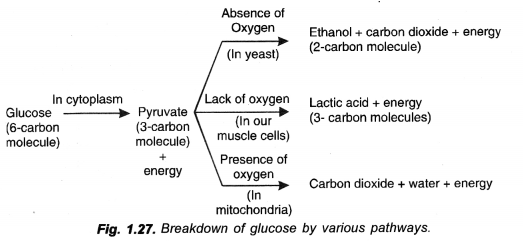
Question 44.
Describe the flow of blood through heart of human beings.
Answer:
It is passage of the same blood twice through the heart first on the right side, then on the left side in order to complete one cycle. Double circulation has two components, pulmonary circulation and systemic circulation.
- Pulmonary Circulation: It is movement of blood from heart to the lungs and back. Deoxygenated blood of the body enters the right auricle, passes into right ventricle which pumps it into pulmonary arch. With the help of two separate pulmonary arteries the blood passes into the lungs. Here, it is oxygenated. Oxygenated blood comes back to left auricle of heart through four pulmonary veins, two from each lung.
- Systemic Circulation: It is the circulation of blood between heart and different parts of the body except lungs. Oxygenated blood received by left auricle passes into left ventricle. The left ventricle pumps it into aorta for supply to different body parts including walls of the heart by means of arteries. Inside the organs the blood loses oxygen and nutrients. It picks up carbon dioxide and waste products. This deoxygenated blood is drained by veins and sent to the right auricle of heart.
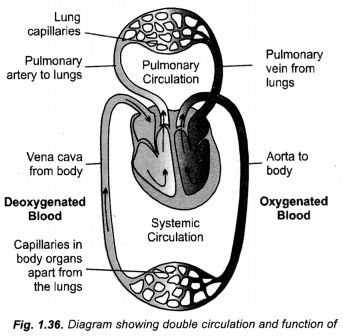
Question 45.
Describe the process of urine formation in kidneys.
Answer:
Mechanism of Urine Formation:
It has four components — glomerular filtration, selective reabsorption, tubular secretion and concentration.
- Glomerular Filtration: Blood flows in glomerulus under pressure due to narrowness of efferent arteriole. As a result it undergoes pressure filtration or ultrafiltration. All small volume solutes (e.g., urea, uric acid, amino acids, hormones, glucose, ions, vitamins) and water are filtered out and enter the Bowman’s capsule. The product is called nephric or glomerular filtrate. Its volume is 125 ml/min (180 litres/day).
- Reabsorption: Nephric filtrate is also called primary urine. It passes into proximal convoluted tubule. The peritubular capillaries around PCT reabsorb all the useful components of nephric filtrate, e.g, glucose, amino acids, vitamins C, calcium, potassium, sodium, chloride, bicarbonate and water (75%). Selective reabsorption also occurs in the region of distal convoluted tubule. The amount of water absorption depends upon amount of excess water present in the body and the amount of dissolved waste to be excreted.
- Tubular Secretion (Augmentation): It occurs mostly in the distal convoluted tubule which is also surrounded by peritubular capillaries. Smaller amount of tubular secretion also takes place in the area of proximal convoluted tubule. Tubular secretion is active secretion of waste products by the blood capillaries into the urinary tubule. It ensures removal of all the waste products from blood, viz.,’ urea, uric acid, creatinine. Extra salts, K+ and H+ are also secreted into urinary tubule to maintain a proper concentration and pH of the urine.
- Concentration of the Urine: 75% of water content of nephric filtrate is reabsorbed in the region of proximal convoluted tubule. Some 10% of water passes out of the filtrate through osmosis in the area of loop of Henle. It is because loops of Henle are immersed in hyper-osmotic interstitial fluid, Further concentration takes place in the area of collecting tubes in the presence of hormone called antidiuretic hormone (ADH) or vasopressin. The hormone is secreted only when concentrated urine is to be passed out. It is not secreted when a person drinks a lot of water. Absence of antidiuretic hormone produces a dilute urine. Hormone action, therefore, maintains osmotic concentration of body fluids. Deficiency of ADH causes excessive, repeated, dilute urination (diabetes insipidus).
Hope given NCERT Exemplar Solutions for Class 10 Science Chapter 6 Life Processes are helpful to complete your science homework.
If you have any doubts, please comment below. Learn Insta try to provide online science tutoring for you.